Frank's travels around Britain.
Beachy head to
Stonehenge.
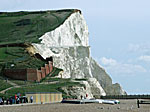 If the weather is lovely, do what you fancy, let your head rule any sense you
have & go for it. I got in a lodge around Avebury, I had a choice of what to do. See if
the weather is worse tomorrow, and then I could get some menace into the henge
photographs, with darker clouds. So its the south coast run first! If you just travel, its amazing where you
can end up! I headed for the coast and travelled east. Fast roads, dull frontage
& I end up at Beachy Head, the first dramatic chalk cliffs along the coast.
Anyone visiting Beachy Head and the
Village of East Dean will notice that the lovely flint cottages have very
distinctive green doors and gutters. The Green, not to be mistaken with the
National Trust Green, is the Estate colour of the Gilbert Family who have owned
land and lived in this area of East Sussex since 1661. The Gilbert Estate
comprises lands stretching from East Dean and Beachy head to Pevensey Castle and
Pevensey marshes. History shows that the Gilbert and Cavendish (Duke of
Devonshire) families were the proud owners and designers of Eastbourne, a town
that was referred to as being built by Gentlemen for Gentlemen.
If the weather is lovely, do what you fancy, let your head rule any sense you
have & go for it. I got in a lodge around Avebury, I had a choice of what to do. See if
the weather is worse tomorrow, and then I could get some menace into the henge
photographs, with darker clouds. So its the south coast run first! If you just travel, its amazing where you
can end up! I headed for the coast and travelled east. Fast roads, dull frontage
& I end up at Beachy Head, the first dramatic chalk cliffs along the coast.
Anyone visiting Beachy Head and the
Village of East Dean will notice that the lovely flint cottages have very
distinctive green doors and gutters. The Green, not to be mistaken with the
National Trust Green, is the Estate colour of the Gilbert Family who have owned
land and lived in this area of East Sussex since 1661. The Gilbert Estate
comprises lands stretching from East Dean and Beachy head to Pevensey Castle and
Pevensey marshes. History shows that the Gilbert and Cavendish (Duke of
Devonshire) families were the proud owners and designers of Eastbourne, a town
that was referred to as being built by Gentlemen for Gentlemen.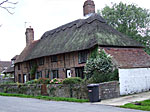
 It
was in this area I saw the Long Man of Wilmington, a figure carved out of the
chalk hillside.
It
was in this area I saw the Long Man of Wilmington, a figure carved out of the
chalk hillside.
The following is quoted from a website:
The Long Man of Wilmington,
mysterious guardian of the South Downs, has baffled archaeologists and
historians for hundreds of years.
I was now a long way from the lodge at Durrington! On the road back, I decided
that, as the area had not only henge's but more white horses, I'd try to pack in
one day (didn't quite make it!) Stone henge, Avebury circle and all the White
horses I could muster!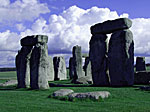
 With its age is from around 3100BC.
Stonehenge was constructed in three phases, It has been estimated that the three
phases of the construction required more than thirty million hours of
labour. Speculation on the reason it was built range from human sacrifice to
astronomy. The day was beautiful & it looked far to good! I really wanted the
ominous feeling you get as you circle the stones. The clouds were there but the
aura you sense didn't show in the lovely pictures!
Christopher Chippindale's “Stonehenge
Complete” gives the derivation of Stonehenge as coming from the Old English
words "stān" meaning "stone", and either "hencg" meaning "hinge" (because the
stone lintels hinge on the upright stones) or "hen(c)en" meaning "gallows" or
"instrument of torture". Stonehenge is a "henge monument" meaning that it
consists of menhirs (large rocks) in a circular formation. Medieval gallows
consisted of two uprights with a lintel joining them, resembling Stonehenge's
trilithons, rather than looking like the inverted L-shape more familiar today.
With its age is from around 3100BC.
Stonehenge was constructed in three phases, It has been estimated that the three
phases of the construction required more than thirty million hours of
labour. Speculation on the reason it was built range from human sacrifice to
astronomy. The day was beautiful & it looked far to good! I really wanted the
ominous feeling you get as you circle the stones. The clouds were there but the
aura you sense didn't show in the lovely pictures!
Christopher Chippindale's “Stonehenge
Complete” gives the derivation of Stonehenge as coming from the Old English
words "stān" meaning "stone", and either "hencg" meaning "hinge" (because the
stone lintels hinge on the upright stones) or "hen(c)en" meaning "gallows" or
"instrument of torture". Stonehenge is a "henge monument" meaning that it
consists of menhirs (large rocks) in a circular formation. Medieval gallows
consisted of two uprights with a lintel joining them, resembling Stonehenge's
trilithons, rather than looking like the inverted L-shape more familiar today.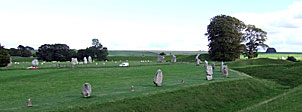
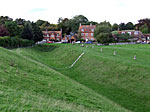 Only about 25 miles away is an arguably
better site in the Avebury circle, where a village lives amongst another ancient
stones, argued to be the most impressive of all remaining prehistoric earthworks
in Europe. Its approximate age is 2400BC, about 700 years after Stonehenge.
That's like us thinking of 1300. that was the time of the hundred years war &
the Black death. Would people in the local have any connection with Stonehenge?
Did time move so slowly, unlike today where it changes daily. It is certainly
easy to trick your mind into believing that their echo's and vibrations are
still there, deep in the stones.
Only about 25 miles away is an arguably
better site in the Avebury circle, where a village lives amongst another ancient
stones, argued to be the most impressive of all remaining prehistoric earthworks
in Europe. Its approximate age is 2400BC, about 700 years after Stonehenge.
That's like us thinking of 1300. that was the time of the hundred years war &
the Black death. Would people in the local have any connection with Stonehenge?
Did time move so slowly, unlike today where it changes daily. It is certainly
easy to trick your mind into believing that their echo's and vibrations are
still there, deep in the stones.
 From
a website: Similar
to Stonehenge and many other megalithic monuments in the British Isles, Avebury
is a composite construction that was added to and altered during several
periods. As the site currently exists, the great circle consists of a
grass-covered, chalk-stone bank that is 1,396 feet in diameter (427 meters) and
20 feet high (6 meters) with a deep inner ditch having four entrances at the
cardinal compass points. Just inside the ditch, which was clearly not used for
defensive purposes, lies a grand circle of massive and irregular sarsen stones
enclosing approximately 28 acres of land. This circle, originally composed of at
least 98 stones but now having only 27, itself encloses two smaller stone
circles. The two inner circles were probably constructed first, around 2600 BC,
while the large outer ring and earthwork dates from 2500 BC. The northern circle
is 320 feet in diameter and originally had twenty-seven stones of which only
four remain standing today; the southern circle is 340 feet across and once
contained twenty-nine stones, of which only five remain standing.
From
a website: Similar
to Stonehenge and many other megalithic monuments in the British Isles, Avebury
is a composite construction that was added to and altered during several
periods. As the site currently exists, the great circle consists of a
grass-covered, chalk-stone bank that is 1,396 feet in diameter (427 meters) and
20 feet high (6 meters) with a deep inner ditch having four entrances at the
cardinal compass points. Just inside the ditch, which was clearly not used for
defensive purposes, lies a grand circle of massive and irregular sarsen stones
enclosing approximately 28 acres of land. This circle, originally composed of at
least 98 stones but now having only 27, itself encloses two smaller stone
circles. The two inner circles were probably constructed first, around 2600 BC,
while the large outer ring and earthwork dates from 2500 BC. The northern circle
is 320 feet in diameter and originally had twenty-seven stones of which only
four remain standing today; the southern circle is 340 feet across and once
contained twenty-nine stones, of which only five remain standing.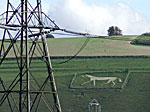
 On
the way home, I tried to photograph some of the White horses in the area. None
were as good as the one in Wiltshire near Calne & one was truly pathetic, but as
it was on a map, I hunted & found it! Don't bother! The Marlborough, or Preshute
horse lies in the grounds of Marlborough College and is the smallest known horse
measuring just 61ft by 47ft. The horse was cut in 1804 by a party of boys from
Mr. Greasley's academy. William Canning, a student at Mr Greasley's is said to
have designed the horse, although there seems to be no real motive behind the
making. To find it, I was in the collage grounds around the tennis courts! The
other I found was better. The Pewsey horse was designed by George Marples
- an authority in hill figures, and was cut by the Pewsey Fire Brigade in 1937
to commemorate the Coronation of George VI. So this is like yesterday as far as
chalk horses go! The horse is one of the smallest figures measuring 66ft by 45ft
and is best viewed from the Pewsey to Amesbury A345 road.
On
the way home, I tried to photograph some of the White horses in the area. None
were as good as the one in Wiltshire near Calne & one was truly pathetic, but as
it was on a map, I hunted & found it! Don't bother! The Marlborough, or Preshute
horse lies in the grounds of Marlborough College and is the smallest known horse
measuring just 61ft by 47ft. The horse was cut in 1804 by a party of boys from
Mr. Greasley's academy. William Canning, a student at Mr Greasley's is said to
have designed the horse, although there seems to be no real motive behind the
making. To find it, I was in the collage grounds around the tennis courts! The
other I found was better. The Pewsey horse was designed by George Marples
- an authority in hill figures, and was cut by the Pewsey Fire Brigade in 1937
to commemorate the Coronation of George VI. So this is like yesterday as far as
chalk horses go! The horse is one of the smallest figures measuring 66ft by 45ft
and is best viewed from the Pewsey to Amesbury A345 road.
Links for information on this page:
